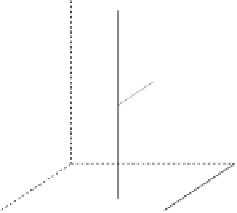Information Technology Reference
In-Depth Information
Let
A
be an MCI of a cube
C
. The vertices of
A
are divided into two cat-
egories:
v-vertices
, which are also vertices of
C
,and
e-vertices
, which are not
vertices of
C
. We denote by
V
(
A
) the set of v-vertices of
A
.
Definition 2.
A
0/0.5/1 MCI of C
is an MCI with its e-vertices at middle
points of the edges of
C
.
Each object in Fig.
1
is a 0/0.5/1 MCI. Note that a regular tetrahedron has only
v-vertices and a cuboctahedron has only e-vertices.
For a polytope
A
, a subset of vert(
A
) is called a star if it is composed of a
vertex and all of its adjacent vertices.
Theorem 3 (Theorem 3 and Corollary 4 of
[
1
]
).
There is one-to-one corre-
spondence between 0/0.5/1 MCIs of
C
and subsets of
vert(
C
)
that do not contain
any star as their subset. There are 15 0/0.5/1 MCI shapes.
Proof.
For an MCI
A
of
C
,
V
(
A
) does not contain any star because of its mini-
mality. On the other hand, from a subset
S
vert(
C
) without a star, we obtain
an MCI by selecting its e-vertices on middle points of the edges of
C
both of
whose endpoints are not in
S
.
There are 15 equivalence classes of subsets of vert(
C
) without a star. Here,
two subsets of vert(
C
) are equivalent if one is transformed to the other by an
isometry which fixes
C
. We can easily check that every pair of them induces
non-similar 0/0.5/1 MCIs. Therefore, there are 15 0/0.5/1 MCI shapes.
ↂ
We say that two MCIs
A
and
A
of
C
are
v-equivalent
if
V
(
A
) can be transformed
to
V
(
A
) by an isometry which fixes
C
. There is a representative 0/0.5/1 MCI
in each v-equivalence class. The list of all 0/0.5/1 MCIs is given in [
1
].
We define a
double imaginary cube
as an imaginary cube of two different
cubes. As Fig.
3
shows, an H (Fig.
1
(c)) is the intersection of two cubes and is a
double imaginary cube. It is shown that all the convex double imaginary cubes
are intersections of two cubes of the same size which share a diagonal and thus
they are MCIs v-equivalent to H [
1
, Proposition 5].
We call an
n
-dimensional polytope with 2
n
vertices a
weak cross-polytope
if its
vertices are on the positive and the negative sides of a set of axes of coordinates,
z
y
x
Fig. 3.
H as the intersection of two
cubes.
Fig. 4.
T as a weak polytope.











































































Search WWH ::

Custom Search